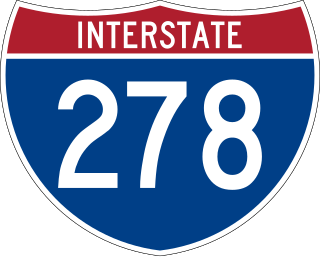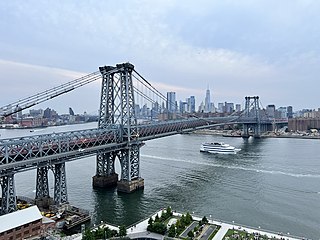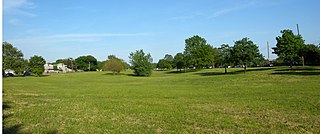Related Research Articles

Brooklyn is a borough of New York City. Located on the westernmost edge of Long Island, it is coextensive with Kings County in the U.S. state of New York. With 2,736,074 residents as of the 2020 United States census, Kings County is the most populous of the five boroughs of New York City and the most populous county in the State of New York. The population density of Brooklyn was 37,339.9 inhabitants per square mile (14,417.0/km2) in 2022, making it the second-most-densely-populated county in the United States, behind Manhattan, and it had the ninth-highest population of any county nationwide. Were Brooklyn still an independent city, it would be the fourth most populous in the U.S. after the rest of New York City, Los Angeles, and Chicago.

The Brooklyn Bridge is a hybrid cable-stayed/suspension bridge in New York City, spanning the East River between the boroughs of Manhattan and Brooklyn. Opened on May 24, 1883, the Brooklyn Bridge was the first fixed crossing of the East River. It was also the longest suspension bridge in the world at the time of its opening, with a main span of 1,595.5 feet (486.3 m) and a deck 127 ft (38.7 m) above mean high water. The span was originally called the New York and Brooklyn Bridge or the East River Bridge but was officially renamed the Brooklyn Bridge in 1915.

The Queensboro Bridge, officially named the Ed Koch Queensboro Bridge, is a cantilever bridge over the East River in New York City. Completed in 1909, it connects the Long Island City neighborhood in the borough of Queens with the East Midtown and Upper East Side neighborhoods in Manhattan, passing over Roosevelt Island. The bridge is also known as the 59th Street Bridge. It consists of five steel spans measuring 3,725 ft (1,135 m) long; including approaches, its total length is 7,449 ft (2,270 m).

Prospect Park is an urban park in the New York City borough of Brooklyn. The park is situated between the neighborhoods of Park Slope, Prospect Heights, Prospect Lefferts Gardens, Flatbush, and Windsor Terrace, and is adjacent to the Brooklyn Museum, Grand Army Plaza, and the Brooklyn Botanic Garden. With an area of 526 acres (213 ha), Prospect Park is the second-largest public park in Brooklyn, behind Marine Park. Designated as a New York City scenic landmark and listed on the National Register of Historic Places, Prospect Park is operated by the Prospect Park Alliance and NYC Parks.

Interstate 278 (I-278) is an auxiliary Interstate Highway in New Jersey and New York in the United States. The road runs 35.62 miles (57.32 km) from US Route 1/9 (US 1/9) in Linden, New Jersey, northeast to the Bruckner Interchange in the New York City borough of the Bronx. The majority of I-278 is in New York City, where it serves as a partial beltway and passes through all five of the city's boroughs. I-278 follows several freeways, including the Union Freeway in Union County, New Jersey; the Staten Island Expressway (SIE) across Staten Island; the Gowanus Expressway in southern Brooklyn; the Brooklyn–Queens Expressway (BQE) across northern Brooklyn and Queens; a small part of the Grand Central Parkway in Queens; and a part of the Bruckner Expressway in the Bronx. I-278 also crosses multiple bridges, including the Goethals, Verrazzano-Narrows, Kosciuszko, and Robert F. Kennedy bridges.
The Triborough Bridge and Tunnel Authority (TBTA), doing business as MTA Bridges and Tunnels, is an affiliate agency of the Metropolitan Transportation Authority that operates seven toll bridges and two tunnels in New York City. In terms of traffic volume, it is the largest bridge and tunnel toll agency in the United States, serving more than a million people each day and generating more than $1.9 billion in toll revenue annually as of 2017. As of 2018, its budget was $596 million, funded through taxes and fees.

The Manhattan Bridge is a suspension bridge that crosses the East River in New York City, connecting Lower Manhattan at Canal Street with Downtown Brooklyn at the Flatbush Avenue Extension. Designed by Leon Moisseiff and built by the Phoenix Bridge Company, the bridge has a total length of 6,855 ft (2,089 m). It is one of four toll-free vehicular bridges connecting Manhattan Island to Long Island; the nearby Brooklyn Bridge is just slightly farther west, while the Queensboro and Williamsburg bridges are to the north.

The Brooklyn Rapid Transit Company (BRT) was a public transit holding company formed in 1896 to acquire and consolidate railway lines in Brooklyn and Queens, New York City, United States. It was a prominent corporation and industry leader using the single-letter symbol B on the New York Stock Exchange.
The Brooklyn–Battery Tunnel, officially the Hugh L. Carey Tunnel and commonly referred to as the Battery Tunnel or Battery Park Tunnel, is a tolled tunnel in New York City that connects Red Hook in Brooklyn with the Battery in Manhattan. The tunnel consists of twin tubes that each carry two traffic lanes under the mouth of the East River. Although it passes just offshore of Governors Island, the tunnel does not provide vehicular access to the island. With a length of 9,117 feet (2,779 m), it is the longest continuous underwater vehicular tunnel in North America.
The Queens–Midtown Tunnel is a vehicular tunnel under the East River in New York City, connecting the boroughs of Manhattan and Queens. The tunnel consists of a pair of tubes, each carrying two lanes. The west end of the tunnel is located on the East Side of Midtown Manhattan, while the east end of the tunnel is located in Long Island City in Queens. The tunnel carries Interstate 495 (I-495) for its entire length; I-495's western terminus is at the Manhattan portal of the tunnel.

The Williamsburg Bridge is a suspension bridge across the East River in New York City, connecting the Lower East Side of Manhattan with the Williamsburg neighborhood of Brooklyn. Originally known as the East River Bridge, the Williamsburg Bridge was completed in 1903 and, at 7,308 feet (2,227 m) long, was the longest suspension bridge span in the world until 1924. Leffert L. Buck was the bridge's chief engineer.

The City of Greater New York was the term used by many politicians and scholars for the expanded City of New York created on January 1, 1898, by consolidating the existing City of New York with Brooklyn, western Queens County, and Staten Island. The section of the Bronx west of the Bronx River had been annexed to the City and County of New York in 1874 and was known as the Annexed District. The section of the Bronx east of the Bronx River had been annexed to the City and County of New York in 1895.
The BMT Jamaica Line, also known as the Broadway - Brooklyn Line is an elevated rapid transit line of the B Division of the New York City Subway, in Brooklyn and Queens, New York City, United States. It runs from the Williamsburg Bridge southeast over Broadway to East New York, Brooklyn, and then east over Fulton Street and Jamaica Avenue to Jamaica, Queens. In western Jamaica, the line goes into a tunnel, becoming the lower level of the Archer Avenue lines in central Jamaica. The J and Z trains serve the entire length of the Jamaica Line, and the M serves the line west of Myrtle Avenue.

The Kosciuszko Bridge is a cable-stayed bridge over Newtown Creek in New York City, connecting Greenpoint in Brooklyn to Maspeth in Queens. The bridge consists of a pair of cable-stayed bridge spans: the eastbound span opened in April 2017, while the westbound span opened in August 2019. An older bridge, a truss bridge of the same name that was located on the site of the westbound cable-stayed span, was originally opened in 1939 and was closed and demolished in 2017. The crossing is part of the Brooklyn–Queens Expressway (BQE), which carries Interstate 278.

The New York City Department of Transportation (NYCDOT) is the agency of the government of New York City responsible for the management of much of New York City's transportation infrastructure. Ydanis Rodriguez is the Commissioner of the Department of Transportation, and was appointed by Mayor Eric Adams on January 1, 2022. Former Commissioners have included Polly Trottenberg, Janette Sadik-Khan, and Iris Weinshall. Their Training Center is located at 140 General R W Berry Dr, Queens, NY 11359, off of Exit 32 of the Cross Island Parkway.
The Broadway Line was a public transit line in Brooklyn, New York City, United States along Broadway between Williamsburg and East New York. Originally a streetcar line, it later became a bus route, but no bus currently operates over the entire length of Broadway, with the BMT Jamaica Line above.

James Samuel Thomas Stranahan was a United States Representative from New York, and a municipal official of the City of Brooklyn.

Conduit Avenue is an arterial road in New York City, the vast majority of which is in Queens. The divided highway runs from Atlantic Avenue in Cypress Hills, Brooklyn to Hook Creek Boulevard in Rosedale, Queens at the Nassau County border. The thoroughfare is named after an aqueduct in its right-of-way.

Grand Street Bridge is a through-truss swing bridge over Newtown Creek in New York City. The current crossing was completed in 1902, and links Grand Street and Grand Avenue via a two-lane, height-restricted roadway. It is a main connection between the boroughs of Brooklyn and Queens, carrying an average of 10,200 vehicles per day.

Sunswick Creek is a buried stream located in Astoria and Long Island City, in the northwestern portion of Queens in New York City. It originated to the north of Queensboro Bridge and Queens Plaza in Long Island City, flowing north to the present-day site of the Socrates Sculpture Park in Astoria, and emptying into the East River. The creek was named for a term in the Algonquin language that likely means "Woman Chief" or "Sachem’s Wife."
References
- 1 2 3 Ash, Mark (1897). The Greater New York Charter as Enacted in 1897 (PDF). New York City: Weed-Parsons Printing Company . Retrieved February 25, 2024.
- ↑ "Leading Features of the New Charter". The Brooklyn Daily Eagle . December 26, 1896. pp. 1–2. Retrieved February 25, 2024.
- ↑ "NYC Municipal Archives Collections: Bridges/Plant & Structures". New York City Department of Records & Information Services . Retrieved February 25, 2024.
- ↑ "Guide to the Board of Supervisors of Kings County collection ARC.049". dlib.nyu.edu. Retrieved June 30, 2021.
- ↑ "Rural Improvements" (PDF). The New York Times . August 4, 1873. Retrieved February 25, 2024.
- ↑ "Wants the Small Bridges– Deputy Farrell Regards Them as Parts of Highways". The Brooklyn Daily Eagle . January 7, 1898. Retrieved February 25, 2024.
- ↑ "Maintenance Personnel Resources in 1900" (PDF). NYCDOT Bridges & Tunnels Annual Condition Report: 232. 2003. Retrieved February 25, 2024.
- ↑ "The City Appointments" (PDF). The New York Times . January 1, 1898. Retrieved February 25, 2024.
- ↑ Griggs, Jr., Frank. "Great Achievements: Gustav Lindenthal" (PDF). STRUCTURE Magazine (August 2010): 56–57. Retrieved February 25, 2024.
- ↑ "More City Appointees" (PDF). The New York Times . December 25, 1903. p. 3. Retrieved February 25, 2024.
- ↑ "Tully to Get Bouck's Job; Brooklyn to Lose Nothing". The Brooklyn Daily Eagle . December 29, 1905. Retrieved February 25, 2024.
- ↑ "Gaynor's Appointments". The Yonkers Statesman . January 3, 1910. Retrieved February 25, 2024.
- ↑ "O'Keeffe Takes Charge as Martin Steps Out". The Brooklyn Daily Eagle . June 7, 1911. Retrieved February 25, 2024.
- ↑ "The New Bridge Commissioner". The Standard Union . January 2, 1914. Retrieved February 25, 2024.